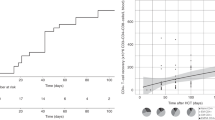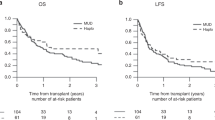Summary:
This retrospective study compares the reconstitution of T, B and NK cells in three groups of patients transplanted for haematological malignancies with grafts from their HLA-identical sibling donors. In all, 15 patients received PBSC after a nonmyeloablative conditioning regimen consisting of fludarabine and 200 cGy TBI, 13 patients received PBSC after myeloablative conditioning and 37 patients received BM after myeloablative conditioning. In the nonmyeloablative group, the NK cells normalised after 1 month, the CD8+ T cells normalised after 3 months, the CD4+ T cells reached near normal values after 9 months and the B cell values were reduced until 12 months after transplant. In the two myeloablative groups, recipients of PBSC had a significantly higher number of CD4+ T cells after 4 months (P=0.004) and after 12 months (P=0.001), than recipients of BM. We found no differences in the T cell reconstitution between the two PBSC groups. This was of interest as the recipients of nonmyeloablative conditioning were older (P<0.001) and had a higher occurrence of chronic GVHD (P<0.05) than the recipients of myeloablative conditioning. In contrast, the recipients of nonmyeloablative conditioning had a delayed B cell recovery when compared to the patients who received myeloablative conditioning (P=0.04).
This is a preview of subscription content, access via your institution
Access options
Subscribe to this journal
Receive 12 print issues and online access
$259.00 per year
only $21.58 per issue
Buy this article
- Purchase on Springer Link
- Instant access to full article PDF
Prices may be subject to local taxes which are calculated during checkout





Similar content being viewed by others
References
McSweeney PA, Niederwieser D, Shizuru JA et al. Hematopoietic cell transplantation in older patients with hematologic malignancies: replacing high-dose cytotoxic therapy with graft-versus-tumor effects. Blood 2001; 97: 3390–3400.
Giralt S, Thall PF, Khouri I et al. Melphalan and purine analog-containing preparative regimens: reduced-intensity conditioning for patients with hematologic malignancies undergoing allogeneic progenitor cell transplantation. Blood 2001; 97: 631–637.
Storek J, Witherspoon RP . Immunologic reconstitution after hematopoietic stem cell transplantation. In: Atkinson K (ed.). Clinical Bone Marrow and Blood Stem Cell Transplantation. Cambridge University Press: Cambridge, UK 2000, pp 111–146.
Storek J, Gooley T, Witherspoon RP et al. Infectious morbidity in long-term survivors of allogeneic marrow transplantation is associated with low CD4 T cell counts. Am J Hematol 1997; 54: 131–138.
Storek J, Espino G, Dawson MA et al. Low B cell and monocyte counts on day 80 are associated with high infection rates between days 100 and 365 after allogeneic marrow transplantation. Blood 2000; 96: 3290–3293.
Chung B, Barbara-Burnham L, Barsky L et al. Radiosensitivity of thymic interleukin-7 production and thymo-poiesis after bone marrow transplantation. Blood 2001; 98: 1601–1606.
Roux E, Dumont-Girard F, Starobinski M et al. Recovery of immune reactivity after T cell-depleted bone marrow transplantation depends on thymic activity. Blood 2000; 96: 2299–2303.
Douek DC, Vescio RA, Betts MR et al. Assessment of thymic output in adults after haematopoietic stem-cell transplantation and prediction of T cell reconstitution. Lancet 2000; 355: 1875–1881.
Jakobsen BK, Ryder LP, Ladefoged J et al. Strong impact of HLA-DR-matching on graft survival in 413 consecutive cadaver kidney transplants performed in Copenhagen over an eight-year period. Transplant Proc 1995; 27: 3452–3453.
Olerup O, Zetterquist H . HLA-DR typing by PCR amplification with sequence-specific primers (PCR- SSP) in 2 hours: an alternative to serological DR typing in clinical practice including donor–recipient matching in cadaveric transplantation. Tissue Antigens 1992; 39: 225–235.
Sullivan KM . Graft-vs-Host Disease. In: Donnall Thomas E, Blume KG, Forman SJ (eds) Hematopoietic Cell Transplantation. Blackwell Science: Malden, 1999, pp 518–525.
Ottinger HD, Beelen DW, Scheulen B et al. Improved immune reconstitution after allotransplantation of peripheral blood stem cells instead of bone marrow. Blood 1996; 88: 2775–2779.
Storek J, Dawson MA, Storer B et al. Immune reconstitution after allogeneic marrow transplantation compared with blood stem cell transplantation. Blood 2001; 97: 3380–3389.
Alpdogan O, Schmaltz C, Muriglan SJ et al. Administration of interleukin-7 after allogeneic bone marrow transplantation improves immune reconstitution without aggravating graft-versus-host disease. Blood 2001; 98: 2256–2265.
Mackall CL, Fry TJ, Bare C et al. IL-7 increases both thymic-dependent and thymic-independent T cell regeneration after bone marrow transplantation. Blood 2001; 97: 1491–1497.
Okamoto Y, Douek DC, McFarland RD et al. Effects of exogenous interleukin-7 on human thymus function. Blood 2002; 99: 2851–2858.
Min D, Taylor PA, Panoskaltsis-Mortari A et al. Protection from thymic epithelial cell injury by keratinocyte growth factor: a new approach to improve thymic and peripheral T cell reconstitution after bone marrow transplantation. Blood 2002; 99: 4592–4600.
Shenoy S, Mohanakumar T, Todd G et al. Immune reconstitution following allogeneic peripheral blood stem cell transplants. Bone Marrow Transplant 1999; 23: 335–346.
Schetelig J, Kroger N, Held TK et al. Allogeneic transplantation after reduced conditioning in high risk patients is complicated by a high incidence of acute and chronic graft-versus-host disease. Haematologica 2002; 87: 299–305.
Storek J, Wells D, Dawson MA et al. Factors influencing B lymphopoiesis after allogeneic hematopoietic cell transplantation. Blood 2001; 98: 489–491.
Maury S, Mary JY, Rabian C et al. Prolonged immune deficiency following allogeneic stem cell transplantation: risk factors and complications in adult patients. Br J Haematol 2001; 115: 630–641.
Atkinson K . Reconstruction of the haemopoietic and immune systems after marrow transplantation. Bone Marrow Transplant 1990; 5: 209–226.
Storek J, Joseph A, Dawson MA et al. Factors influencing T-lymphopoiesis after allogeneic hematopoietic cell transplantation. Transplantation 2002; 73: 1154–1158.
Weinberg K, Blazar BR, Wagner JE et al. Factors affecting thymic function after allogeneic hematopoietic stem cell transplantation. Blood 2001; 97: 1458–1466.
Soiffer RJ, Gonin R, Murray C et al. Prediction of graft-versus-host disease by phenotypic analysis of early immune reconstitution after CD6-depleted allogeneic bone marrow transplantation. Blood 1993; 82: 2216–2223.
Storek J, Witherspoon RP, Storb R . T cell reconstitution after bone marrow transplantation into adult patients does not resemble T cell development in early life. Bone Marrow Transplant 1995; 16: 413–425.
Chakrabarti S, Mackinnon S, Chopra R et al. High incidence of cytomegalovirus infection after nonmyeloablative stem cell transplantation: potential role of Campath-1H in delaying immune reconstitution. Blood 2002; 99: 4357–4363.
Savage WJ, Bleesing JJ, Douek D et al. Lymphocyte reconstitution following nonmyeloablative hematopoietic stem cell transplantation follows two patterns depending on age and donor/recipient chimerism. Bone Marrow Transplant 2001; 28: 463–471.
Morecki S, Gelfand Y, Nagler A et al. Immune reconstitution following allogeneic stem cell transplantation in recipients conditioned by low intensity vs myeloablative regimen. Bone Marrow Transplant 2001; 28: 243–249.
Bahceci E, Epperson A, Patibandla A et al. Rapid reconstitution of T cell compartment after non-myeloablative allogeneic stem cell transplantation (NMAT). Blood 1999; 94: 134a (abstr.).
Friedman TM, Varadi G, Hopely DD et al. Nonmyeloablative conditioning allows for more rapid T cell repertoire reconstitution following allogeneic matched unrelated bone marrow transplantation compared to myeloablative approaches. Biol Blood Marrow Transplant 2001; 7: 656–664.
Faucher C, Mothy M, Chabannon C et al. Allogeneic transplantation with ATG based reduced intensity regimen and bone marrow (BM) graft is associated with rapid donor chimerism low GVHD rate and rapid CD8+ T cells recovery. Bone Marrow Transplant 2002; 29: S157 (abstr.).
Busca A, Falda M, Genetta C et al. Immune reconstitution following allogeneic nonmyeloablative stem cell transplantation (NST). Bone Marrow Transplant 2002; 29: S155 (abstr.).
Dodero A, Peccatori J, Olivieri A et al. Kinetics of immune reconstitution and incidence of infections following allogeneic peripheral blood stem cell transplantation in patients conditioned with a reduced-intensity regimen. Bone Marrow Transplant 2002; 29: S155 (abstr.).
Bachl C, Behringer H, Bertz H et al. Lymphocyte reconstitution after transplantation with matched unrelated or related donor PBPC with reduced conditioning (Fludarabin BCNU/Melphalan). Bone Marrow Transplant 2002; 29: S154 (abstr.).
D'Sa SP, Peggs K, Thuraisundaram D et al. CAMPATH-1H-containing nonmyeloablative allogeneic stem cell transplantation for myeloma results in delayed T cell reconstitution and a high incidence of viral infections but low infection-related mortality. Blood 2002; 98: 203a (abstr.).
Malcovati L, Pagnucco G, Bernasconi P et al. Lymphocyte reconstitution following reduced-intensity allogeneic stem cell transplantation. Bone Marrow Transplant 2002; 29: S156 (abstr.).
Baron F, Baudoux E, Frere P et al. Nonmyeloablative stem cell transplantation with CD8-depleted or CD34-selected peripheral blood stem cells. J Hematother Stem Cell Res 2002; 11: 301–314.
Chao NJ, Liu CX, Rooney B et al. Nonmyeloablative regimen preserves “niches” allowing for peripheral expansion of donor T cells. Biol Blood Marrow Transplant 2002; 8: 249–256.
Fujimaki K, Maruta A, Yoshida M et al. Immune reconstitution assessed during five years after allogeneic bone marrow transplantation. Bone Marrow Transplant 2001; 27: 1275–1281.
Martinez C, Urbano-Ispizua A, Rozman C et al. Immune reconstitution following allogeneic peripheral blood progenitor cell transplantation: comparison of recipients of positive CD34+ selected grafts with recipients of unmanipulated grafts. Exp Hematol 1999; 27: 561–568.
Charbonnier A, Sainty D, Faucher C et al. Immune reconstitution after blood cell transplantation. Hematol Cell Ther 1997; 39: 261–264.
Theilgaard-Monch K, Raaschou-Jensen K, Palm H et al. Flow cytometric assessment of lymphocyte, subsets lymphoid progenitors, and hematopoietic stem cells in allogeneic stem cell grafts. Bone Marrow Transplant 2001; 28: 1073–1082.
Hassan HT, Stockschlader M, Schleimer B et al. Comparison of the content and subpopulations of CD3 and CD34 positive cells in bone marrow harvests and G-CSF-mobilized peripheral blood leukapheresis products from healthy adult donors. Transplant Immunol 1996; 4: 319–323.
Acknowledgements
We thank Tina Skov and Anne Bjørlig for excellent technical assistance, and statistician Severin Olesen Larsen for review of the manuscript. This study has been supported by grants from The Danish Cancer Society, The Novo Nordisk Foundation and The Danish Medical Research Council.
Author information
Authors and Affiliations
Rights and permissions
About this article
Cite this article
Petersen, S., Ryder, L., Björk, P. et al. A comparison of T-, B- and NK-cell reconstitution following conventional or nonmyeloablative conditioning and transplantation with bone marrow or peripheral blood stem cells from human leucocyte antigen identical sibling donors. Bone Marrow Transplant 32, 65–72 (2003). https://doi.org/10.1038/sj.bmt.1704084
Received:
Accepted:
Published:
Issue Date:
DOI: https://doi.org/10.1038/sj.bmt.1704084
Keywords
This article is cited by
-
Measuring the cellular memory B cell response after vaccination in patients after allogeneic stem cell transplantation
Annals of Hematology (2020)
-
Possible role of highly activated mucosal NK cells against viral respiratory infections in children undergoing haematopoietic stem cell transplantation
Scientific Reports (2019)
-
Interleukin-21 promotes thymopoiesis recovery following hematopoietic stem cell transplantation
Journal of Hematology & Oncology (2017)
-
Acute myeloid leukemia targets for bispecific antibodies
Blood Cancer Journal (2017)
-
Immune reconstitution in patients with acquired severe aplastic anemia after haploidentical stem cell transplantation
Bone Marrow Transplantation (2017)



